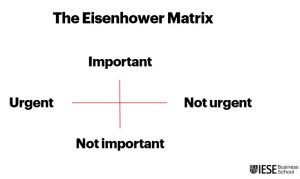
IESE Insight
How to design a schedule that sets you free
Is your day packed with urgent things, but none of them moves you closer to your true goals? Here’s how to manage your time strategically.
“I can’t keep up.” “There’s just so much to do.” “I’m running out of time!” Phrases like these echo through almost every professional environment. Yet some people, regardless of their role — whether in finance, logistics or general management — seem to have a special affinity for managing their time. What are they doing differently?
There are many answers, but most of them boil down to one key skill that makes all the difference: they know how to design their schedule and stick to it.
In a special Alumni session held on IESE’s Barcelona campus, titled “Master your schedule before it masters you,” IESE’s Miquel Llado shared tools and techniques to help regain control of time and focus on what truly creates value.
More than organizing tasks, allocate your time wisely
Time management is a conscious decision. “Your first negotiation every day is with your schedule: if something isn’t on it, it probably won’t happen. And if it does, it will likely be at the expense of your wellbeing,” says Llado.
As Alfred Chandler pointed out in his seminal 1977 management book The Visible Hand, we can drive change through planning, organization and systematic management.
That’s why your schedule should be not just a tool but a lever. Being tactical in what you do is essential, but being strategic in how you think is even more important. The art lies in combing both in a balanced way.
Learn to tell the difference between what’s important and what isn’t
The well-known Eisenhower Matrix can help prioritize tasks — because if you don’t start out by defining what’s important, your agenda will be taken over by what’s urgent, and the result will be more stress and less impact.
- If something is urgent but not important, delegate it.
- If it is neither important nor urgent, don’t do it.
- If something urgent and important is assigned to you, negotiate how you will do it based on your priorities.
- The goal is to spend your time in the ideal quadrant: important but not urgent — the space where real improvement happens.

The best schedule is not full, but well thought out
Being busy doesn’t add value. Prioritizing what matters does. Only those who anticipate can lead, Llado suggests. “Staying ahead of things gives you an edge. It helps you better understand your customer, your team and your environment. It also gives you space to think about what your company could do next.”
Three golden rules for managing your time
Mastering your schedule requires self-leadership. No one should be more rigorous with you than yourself. These three rules can mark a turning point:
- The 10% untouchable rule. Reserve at least 10% of your working time for important, non-urgent activities: thinking, planning, innovating, nurturing relationships and personal development. In a 40-hour week, that means protecting four hours.
- The 3P rule: prioritize, protect, program. Each week, define what is important, block it into your schedule and treat it as non-negotiable. Meeting your own priorities builds trust and credibility with your team, your clients and yourself.
- The first block rule. Start your day with important tasks. The first block is not for putting out fires — it is for working on what requires your best focus. If you leave it for the end of the day, you are unlikely to do it well.
Mastering your schedule will take time, but it will transform the way you lead.
ALSO OF INTEREST
